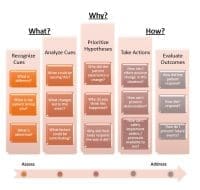Before becoming a nurse manager, I was a nurse case manager at a community hospital where multi-disciplinary rounds (MDRs) were a staple of the day for nurses and social workers. So I was surprised when, after starting my position as a nurse manager for two 30-bed medical/surgical units at another community hospital, the director of case management asked me to collaborate with her and physical therapy to begin rounds. I learned that the previous leadership team didn’t believe in nursing participation in MDRs, and, therefore, physical therapy (PT), case management, social work, and pharmacy were holding their own rounds.
I took a step back and thought about this. Where was nursing input? How did these specialty employees know what, from a clinical perspective, was occurring with these patients? Yes, they could review the healthcare record, but who has time to do that for over 60 patients? In addition, critical information that nurses know may have not reached the record. Immediately after this conversation, with a little push back from nursing and the help of my director, we mandated nursing involvement in MDRs.
Role of multidisciplinary rounds
A multidisciplinary round is a meeting where different members of the multidisciplinary team come together to discuss treatment and discharge planning for patients in a particular area. Stark describes multidisciplinary rounds as a collaborative effort designed to ensure that all of patients’ needs—physically, mentally, and socially— are met before discharge.
MDRs help improve financial and quality metrics, such as length of stay and 30-day readmission rate. In a retrospective study completed in a community hospital, Chava and colleagues found that MDRs reduced length of stay and 30-day readmission in patients with heart failure—effects that also are likely to improve patient satisfaction and quality of care.
Multidisciplinary rounds in action
At my organization, participants represent case management, social work, pharmacy, and nursing, with physicians also sometimes taking part. We discuss each patient’s diagnosis, age, mental status, mobility status, medications, and any barriers to discharge (e.g., pending tests, outstanding lab results).
The time it takes to review more than 60 patients is less than some might think. We typically spend no more than 1 to 2 minutes per patient, and the nurse is usually finished within 5 minutes. On average, we spend 30 minutes on each of my two units, for a total of 1 hour.
Barriers to MDRs that we’ve encountered include nurses not wanting to participate and the length of rounds. When we first mandated nursing involvement in rounds, many nurses were hesitant and nervous to attend because they weren’t sure what they were supposed to do. We eased their anxiety by providing bullet points of what to cover on a whiteboard in the conference room where rounds are held. Another barrier is the different personalities of those who attend. For example, my director and I know that if certain case managers or nurses are on that day, rounds will take a bit longer because they like to give a fuller report. We coach staff to help address this issue. We’ve also learned that if it’s a more complex case, and further discussion is needed, we need to ask participants to continue the discussion “off-line.”
Positive outcomes
My two units have seen great success since implementing nursing participation in MDRs. In May of 2021, when we started MDRs, the average length of stay for patients was 5 days for one unit and, 4.3 for the other. Compare this to an average length of stay of 4.2 for both units in August 2021. Nurses have now incorporated rounds into their day, and some are even excited to participate by telling everyone what’s happening with their patients.
Making a difference
If you want to start MDRs on your unit, my best advice is to encourage participation by explaining the buy-In or the “why.” When I mandated nurses’ involvement, I explained that they would foster easier, smoother, and safer discharges for their patients. Employees need to know and understand why they are doing something, and most will do whatever they can for the safety and well-being of their patients.
Michelle Miller is a nursing manager at Mountainside Medical Center in Montclair, New Jersey.
References
Chava R, Karki N, Ketlogetswe K, Ayala, T. Multidisciplinary rounds in prevention of 30-day readmissions and decreasing length of stay in heart failure patients. Medicine (Baltimore). 2019;98(27): e16233. doi:10.1097/MD.000000000016233
Stark J. Multidisciplinary rounds: Mandatory for case management success. Case Management Monthly. 2017;14(12):8-9.


















